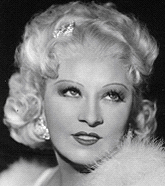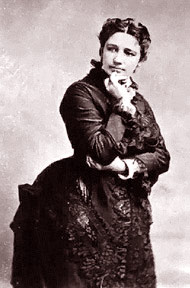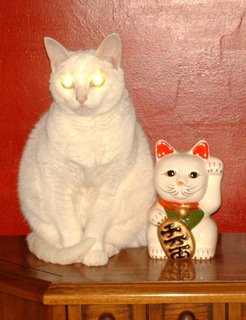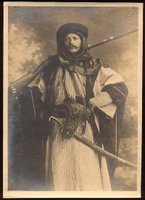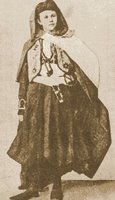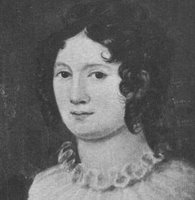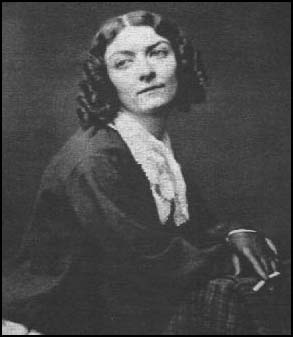When I began chasing after the bad girls of history, I started to keep a list of the personality traits that appealed to me about them. Some women who are traditionally viewed as bad girls, like Marilyn Monroe or Calamity Jane, didn't feel right to me. Marilyn was sexy but a victim, and Calamity wasn't a victim but she wasn't sexy, either.
I've never claimed to be a bona fide historian or a feminist scholar. The list of traits that struck a chord with me as I searched for bad girls was completely idiosyncratic and personal to what I was going through in my life, which was getting a divorce and coming to terms with having no man, no baby, no home, no job and no money. I was pretty pissed off, yo.
I needed inspiration as I rebuilt my life, and I found it by studying Bad Girls. The idea was that having essentially been a nice girl, a "good girl," my whole life had brought me to a place of nothingness. Maybe going in the extreme opposite direction from goodness would help me find a sense of equilibrium. That said, I started to form a personality prototype of who my Ideal Bad Girl would be and I started to write down those traits, like a checklist.
And so now, I present for your delectation the raw list of bad girl traits that I jotted down as I read about the wild women of history. Here we go:
· Came from a disadvantaged background, was ambitious and struggled for success
· Youthful misfortune or indiscretion changes life’s path
· The inciting incidents: A bad and/or arranged marriage in youth (Catherine the Great, Victoria Woodhull, Mae West). Divorce (Elizabeth Chudleigh, Lola Montez) might be the inciting incident that changed her life. (Divorce was common among the bad girls, in an era when it wasn’t common at all.) The incident also might be poverty (Bessie Smith and Skittles), death (Ninon), a chaotically strange family (Isabelle Eberhardt, Empress Theodora), or too much bad sex (Empress Theodora).
· Prostitution might be the inciting incident, or the inciting incident swiftly led to it.
· Experiencing the worst fate for a woman at an early age—the sort of fate that women of her era dreaded and avoided at all costs—she lost her sense of shame when still young and learned to use this to her advantage.
· Despite these shortcomings, a Bad Girls’ big ego saved her: if she wasn’t born royal, she assumed the role, so her youthful suffering was not really an obstacle
· powerful personality with skill of persuasive speaking
· an agile mind, sharp wit, a love of gossip and figuring out the pecking order and where she fit into it—with an eye for rising in position (Empress Theodora, Elizabeth Chudleigh). Used intelligence to judge people, to climb socially
· However, some Bad Girls used their intelligence to carefully observe the social order in order to understand how to escape it. Often, these girls were writers (Mae West, Isabelle Eberhardt, Ninon de Lenclos)
· A Bad Girl could be tremendously charming when she wished.
· vain, beautiful, and if not beautiful, riveting, a face you were drawn to
· girliness: feathers, headdresses, costumes
· knew she shocked & offended people, and this only fueled her rebellion
· did not submit to authority
· lived to please herself
· liked sex
· used sex to achieve personal fulfillment
· had loads of love affairs with men and saw no harm in using them for material gain--often would remain friends when the affair was over
· enjoyed dressing like men, or decided to “live like a man”
· didn’t like other women & preferred the company of men (where the power and the sex were)
· capable of falling deeply in love, but avoided it if she could
· still, every one of these girls had One Great Love of Her Life, l’homme de sa vie
· independent, self-contained, actively resisted becoming too dependent on others
· self-discipline and work were the source of freedom,
· caused apocryphal suicides in sensitive young men, some of whom turned out to be their sons
· motherhood did not define them. Often, the bad girl never carried a child of her own & not interested in demands of motherhood. Though often she would take on nurturing roles with younger lovers and other people’s children.
· was drawn to young people and young people were drawn to her
· she had to have fun, otherwise, why bother?
· either didn’t know about or ignored feminism. made no apologies for being a woman. She was what she was, and that was it.
· Eventually made her own money – lots of it. These girls may not have been feminists, but they were practical. Having known poverty, once they got their hands on some assets, they would never turn them over to a man.
· surrounded by men yet living alone, these women inhabited overwhelmingly lush living spaces that are an extension of their personalities, like Mae West’s boudoir and Skittles’ house. In the case of Isabelle Eberhardt, the vast dunes of the Sahara became the space she inhabited.
· she often shunned alcohol: Ninon de Lenclos, Mae West
· though Bessie Smith, Isabelle Eberhardt were most certainly alcoholics. Elizabeth Chudleigh, possibly
· did not hold back her opinions & could be hurtful
· was the boss of her own show and abused her position,
· some bad girls were physically violent (Lola Montez, Bessie Smith)
· traveled extensively and restlessly,
· inspired people with her passionate nature
· finding religion – spiritual side – usually later in life, though often signs of spirituality in youth. Sexuality as spirituality.
· was preternaturally healthy even as she aged,
· the majority of bad girls live well past the life expectancy of their era, many of them dying in their 80s
· The Bad Girls outlived their critics, and in later life often became adored public figures. In most cases, a bad girl never paid for her sins.



